Wednesday, May 23, 2012
Zooniverse
During class, I have been classifying galaxies on Zooniverse. It is specifically the Galaxy Zoo Hubble project. I would not say this is particularly challenging so maybe that is why I find it boring. I think I like doing hands-on projects, but I understand that of course that is hard to do with astronomy, especially galaxies. At least at a high school level, I think it is near impossible to do any hands-on work with galaxies in a formal lab setting, but if students are interested in this type of work in the future, I think Zooniverse would be a good place to start.
Tuesday, May 22, 2012
Astronomy Cast
Subrahmanyan Chandrasekhar:
While listening to this podcast I learned that Chandra discovered a lot about white dwarfs. Chandra had a very interesting, unconventional life. Coming from a famously scientific family, he grew up in Punjab, which is now Pakistan. He came up with the maximum mass of a white dwarf star while traveling from India. He graduated college in India at age nineteen and then went on to graduate school in Cambridge. Chandra had a very successful career and was a Nobel Laureate.
While listening to this podcast I learned that Chandra discovered a lot about white dwarfs. Chandra had a very interesting, unconventional life. Coming from a famously scientific family, he grew up in Punjab, which is now Pakistan. He came up with the maximum mass of a white dwarf star while traveling from India. He graduated college in India at age nineteen and then went on to graduate school in Cambridge. Chandra had a very successful career and was a Nobel Laureate.
Astronomy Cast
Episode 207: Lyman Spitzer
Before listening to this podcast I only recognized Lyman Spitzer for the Spitzer Space Telescope. However, after listening I learned that he was also a Yale physicist and did a lot of work with plasma physics and star formation. He also spent some time learning how sonars work. I would not necessarily say he had an interesting life (socially) because it seems like he was very typical/what you would expect from a scientist. He was from Ohio and went to prestigious highschools and went on to go to an ivy league college.
I knew he was known for the Spitzer Space telescope but I also learned that he was one of the key people involved with Hubble. This podcast definitely taught me a lot about the life and career of Spitzer that I did not expect.
Before listening to this podcast I only recognized Lyman Spitzer for the Spitzer Space Telescope. However, after listening I learned that he was also a Yale physicist and did a lot of work with plasma physics and star formation. He also spent some time learning how sonars work. I would not necessarily say he had an interesting life (socially) because it seems like he was very typical/what you would expect from a scientist. He was from Ohio and went to prestigious highschools and went on to go to an ivy league college.
I knew he was known for the Spitzer Space telescope but I also learned that he was one of the key people involved with Hubble. This podcast definitely taught me a lot about the life and career of Spitzer that I did not expect.
Friday, May 18, 2012
APOD 4.8
May 15, 2012: All the Water on Planet Earth
Even though we tend to think that there is a lot of water on Earth (since 70 percent of Earth's surface is covered by ocean), there actually is not that much, as this photo demonstrates. The oceans are very shallow in comparison to Earth's radius. If all of the water on Earth were bunched up into a concentrated point, the sphere of water would only have a radius of 700 kilometers which is less than half the radius of our moon. We are unsure if there is water under Earth's surface.
Even though we tend to think that there is a lot of water on Earth (since 70 percent of Earth's surface is covered by ocean), there actually is not that much, as this photo demonstrates. The oceans are very shallow in comparison to Earth's radius. If all of the water on Earth were bunched up into a concentrated point, the sphere of water would only have a radius of 700 kilometers which is less than half the radius of our moon. We are unsure if there is water under Earth's surface.
Wednesday, May 16, 2012
Vera Rubin Biography
Vera
Cooper Rubin, the second daughter of Rose and Philip Cooper, was born on July
23, 1928 in Philadelphia, Pennsylvania.
Since age ten she was interested in astronomy and would constantly look
at the stars. At age fourteen she built
her first telescope with the help of her father. Although she was encouraged by many not to
pursue a career in science, she did so anyways.
She got a scholarship to Vassar College (a women’s college) where she
obtained her bachelor’s degree in astronomy in 1948. From there she attended Cornell where she met
her husband Bob Rubin, a physicist. Originally
she had applied to Princeton but was told that Princeton did not accept women
into their astronomy program. Princeton
only started accepting women into their astronomy program in 1975. She
graduated from Cornell with a master’s degree in 1951. She then attended Georgetown and got her
doctorate from there in 1954.
Interestingly, Vera Rubin does not drive so her husband Bob would drive
her to night classes and sleep in the car in order for her to earn her
doctorate. She also taught and did
research at Georgetown.
In her
research she discovered that galaxies themselves rotate around a central
point. This contradicted the widely
accepted Big Bang Theory at the time which suggested that galaxies just expand
outwards. She presented this thesis to
the American Astronomical Society. She
was somewhat criticized for her theories by the scientific community, but she
still persisted in her research. She also
established the theory of dark matter within galaxies because she realized that
there were unknown forces acting upon these galaxies.
In 1965
she got a job with the Department of Terrestrial Magnetism (of the Carnegie
Institution of Washington), and she has worked in the Carnegie Institution in
D.C. ever since. There she teamed up
with Kent Ford, who had developed a very sensitive spectrometer. With this spectrometer, Ford and Rubin
measured the Doppler shifts across the disks of galaxies. This allowed them to calculate the orbital
speeds of some of the stars in the different regions of the galaxies. This led to the discovery of dark mass.
Vera
Rubin has four children, and several grandchildren. She wrote a children’s book called “My
Grandmother Is an Astronomer” and still does research.
Tuesday, May 15, 2012
Vera Rubin Biography Sources
http://www.sjsu.edu/depts/
http://webs.wichita.edu/lapo/
http://www.answers.com/topic/vera-rubin
http://webs.wichita.edu/lapo/
http://www.answers.com/topic/vera-rubin
Sunday, May 13, 2012
APOD 4.7
May 10, 2012: Green Flash and Super Moon
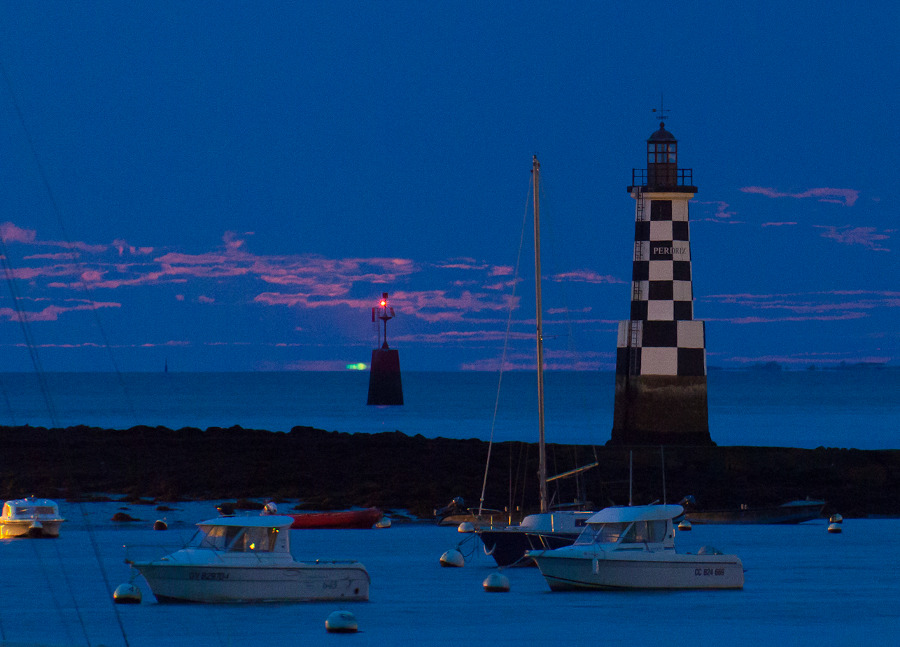
This photograph (of two seconds long exposure) captures the largest full moon of 2012 (green) rising over a harbor on the coast of Brittany, France. The green flash of the supermoon was caused by atmospheric refractions and atmospheric temperature gradients common with a sea horizon.

This photograph (of two seconds long exposure) captures the largest full moon of 2012 (green) rising over a harbor on the coast of Brittany, France. The green flash of the supermoon was caused by atmospheric refractions and atmospheric temperature gradients common with a sea horizon.
Friday, May 11, 2012
APOD 4.6
May 5, 2012: Full Moonrise

The exact full moon will occur on May 6th, 03:36 UT. The above photo is a telephoto image of April's Full Moon above Fort Collins, Colorado. May's Full Moon will appear less than one percent larger than the moon in the above photo. The next opportunity to see a full moon near perigee is June 23 of next year.

The exact full moon will occur on May 6th, 03:36 UT. The above photo is a telephoto image of April's Full Moon above Fort Collins, Colorado. May's Full Moon will appear less than one percent larger than the moon in the above photo. The next opportunity to see a full moon near perigee is June 23 of next year.
Sunday, May 6, 2012
APOD 4.5
April 29,2012
A Dangerous Sunrise on Gliese 876d

This picture is an artistic interpretation of what a sunrise on a planet orbiting the red dwarf star Gliese 876d. Gliese is believed to be very volcanic and it is believed to rotate very slowly so that there is significant difference between night and day. Gliese is so exciting to astronomers because it is one of the few extrasolar planets close to its parent star that may possibly be habitable in the future.
A Dangerous Sunrise on Gliese 876d

This picture is an artistic interpretation of what a sunrise on a planet orbiting the red dwarf star Gliese 876d. Gliese is believed to be very volcanic and it is believed to rotate very slowly so that there is significant difference between night and day. Gliese is so exciting to astronomers because it is one of the few extrasolar planets close to its parent star that may possibly be habitable in the future.
Tuesday, April 24, 2012
APOD 4.4
April 18, 2012
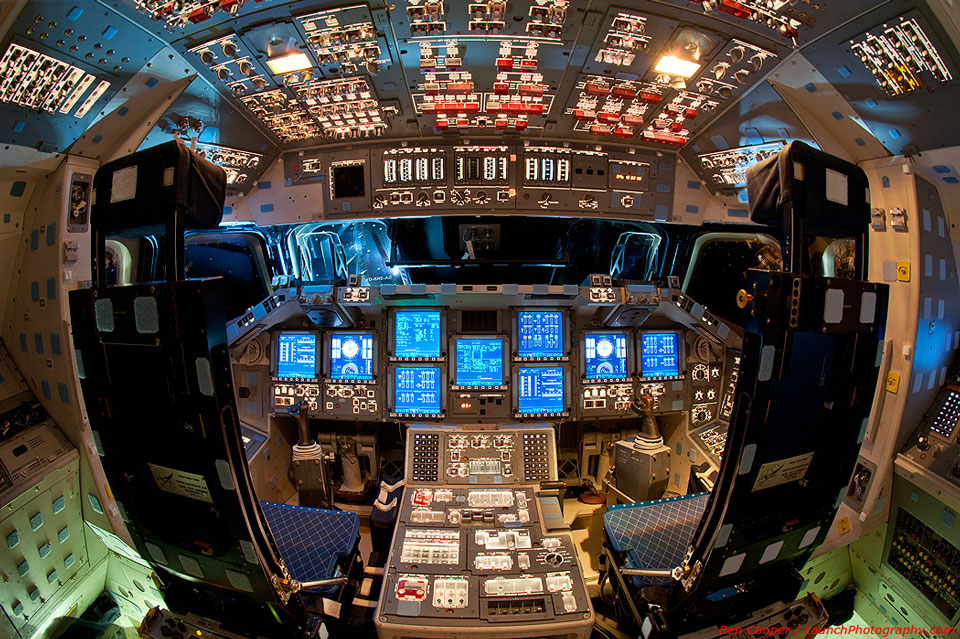
The Flight Deck of Space Shuttle Endeavor
Endeavor is the second to last space shuttle ever launched by NASA. It is capable of entering the Earth's atmosphere at speeds greater than the speed of sound. Since it is now retired, it is going to be sent to the California Space Center in Los Angeles, California. Although it is exciting that we will be able to see space shuttles up close in museums now, I cannot help but be depressed by the shuttles retirement. After all, without being able to use the space shuttle for real missions, it's like viewing a more complex version of Disney's "Mission Space" ride.

The Flight Deck of Space Shuttle Endeavor
Endeavor is the second to last space shuttle ever launched by NASA. It is capable of entering the Earth's atmosphere at speeds greater than the speed of sound. Since it is now retired, it is going to be sent to the California Space Center in Los Angeles, California. Although it is exciting that we will be able to see space shuttles up close in museums now, I cannot help but be depressed by the shuttles retirement. After all, without being able to use the space shuttle for real missions, it's like viewing a more complex version of Disney's "Mission Space" ride.
Sunday, April 15, 2012
APOD 4.3
April 10, 2012: A Fox Fur, a Unicorn, and a Christmas Tree
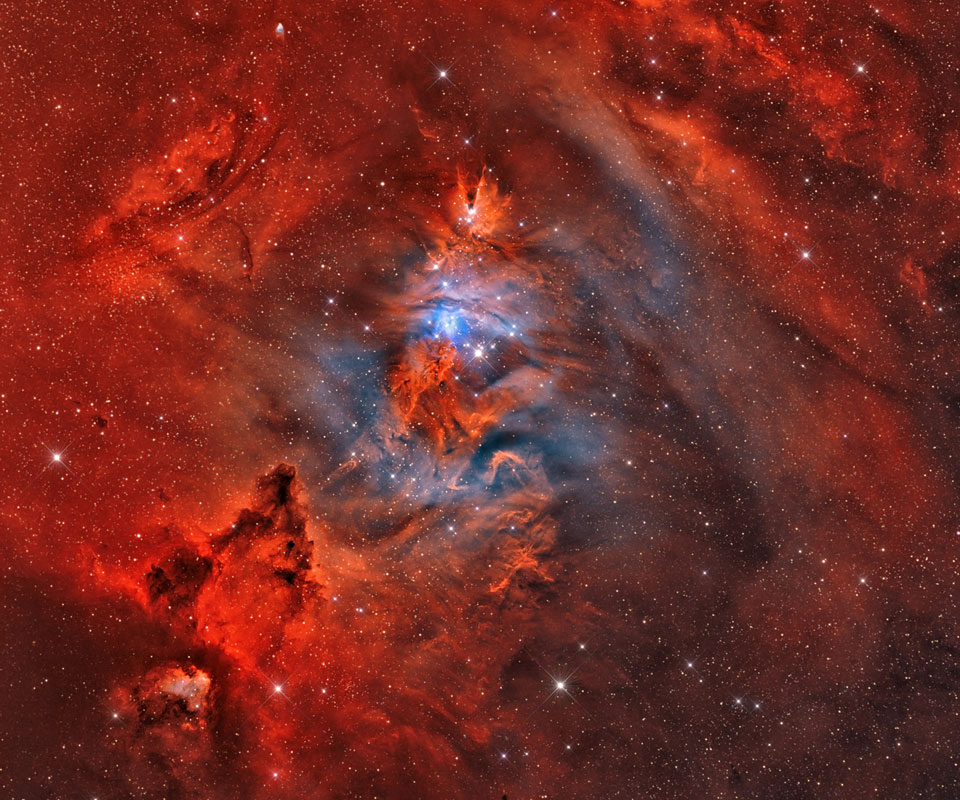
The above picture is of the constellation Monoceros, star forming region NGC 2264. It is roughly 2700 light-years in distance. It mixes red emission nebulae and blue reflection nebulae. This picture specifically includes the Fox Fur Nebula, the Cone Nebula, and S Mon (a young dwarf star which gives the photo a blue glow). The red color in the photo and the Cone Nebula is produced by hydrogen gas.

The above picture is of the constellation Monoceros, star forming region NGC 2264. It is roughly 2700 light-years in distance. It mixes red emission nebulae and blue reflection nebulae. This picture specifically includes the Fox Fur Nebula, the Cone Nebula, and S Mon (a young dwarf star which gives the photo a blue glow). The red color in the photo and the Cone Nebula is produced by hydrogen gas.
APOD 4.2
2 April 2012
Tungurahua Erupts

This photo of Tungurahua (a volcano) was caputured in Ecuador in 2006. It is 5,000 meters high so there are white clouds that flow around the peak of the volcano. The black smoke in the picture is actually dark ash being ejected by the volcano. Also visible in the background of the photo are stars.
Tungurahua Erupts

This photo of Tungurahua (a volcano) was caputured in Ecuador in 2006. It is 5,000 meters high so there are white clouds that flow around the peak of the volcano. The black smoke in the picture is actually dark ash being ejected by the volcano. Also visible in the background of the photo are stars.
Thursday, March 29, 2012
APOD 4.1
3/29/12
Rocket Trails in the Milky Way
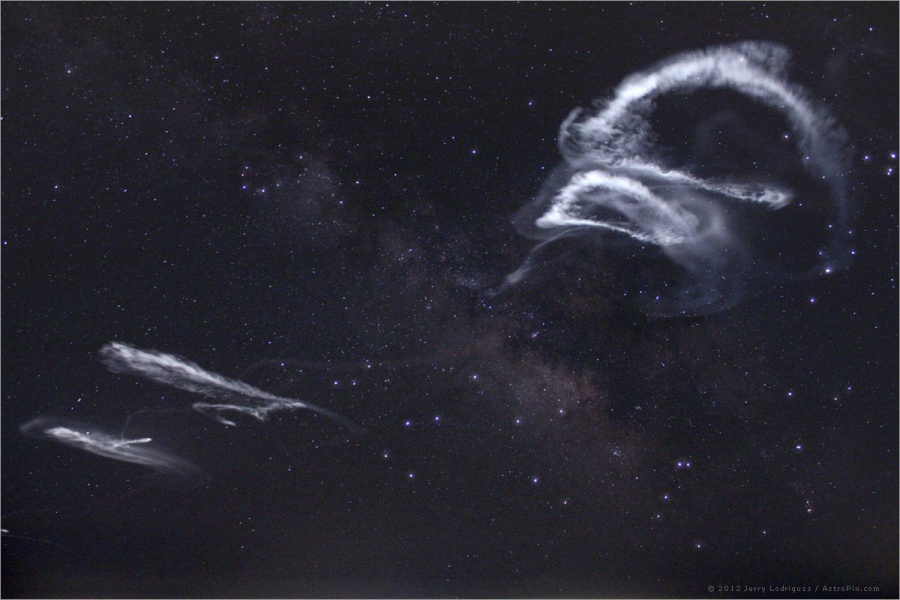
Two days ago, NASA launched five sounding rockets from the Wallops Flight Facility located in Virginia. This photo shows the clouds that the chemical tracer left by the rockets in the Earth's ionosphere (starting at about 80 km). The clouds were able to be seen in the mid-atlantic (this picture specifically captured in New Jersey). Sagittarius and Scorpius are also visible in the background of this picture.
Rocket Trails in the Milky Way

Two days ago, NASA launched five sounding rockets from the Wallops Flight Facility located in Virginia. This photo shows the clouds that the chemical tracer left by the rockets in the Earth's ionosphere (starting at about 80 km). The clouds were able to be seen in the mid-atlantic (this picture specifically captured in New Jersey). Sagittarius and Scorpius are also visible in the background of this picture.
Tuesday, March 27, 2012
Observations
3/27/2012
Yesterday, we were told in class to step outside (at night) to see Jupiter and Venus in conjunction because it was the last night we would have a good view of this event. Although I had seen this over spring break pretty clearly since I was able to stay up later, I decided to go out last night and look for Jupiter, Venus, and the moon. I drove a bit past my neighborhood since it is well lit and once I got to a spot on the road where it was dark I pulled over (I was not alone) and stepped out of my car. I was able to see Jupiter and Venus in a straight line with the moon rather clearly. My mom (who was with me) was also able to see it and she was quite surprised because she really has no idea what to look for. It was definitely an interesting and beautiful thing to see/share and I'm glad there was something different to observe.
Yesterday, we were told in class to step outside (at night) to see Jupiter and Venus in conjunction because it was the last night we would have a good view of this event. Although I had seen this over spring break pretty clearly since I was able to stay up later, I decided to go out last night and look for Jupiter, Venus, and the moon. I drove a bit past my neighborhood since it is well lit and once I got to a spot on the road where it was dark I pulled over (I was not alone) and stepped out of my car. I was able to see Jupiter and Venus in a straight line with the moon rather clearly. My mom (who was with me) was also able to see it and she was quite surprised because she really has no idea what to look for. It was definitely an interesting and beautiful thing to see/share and I'm glad there was something different to observe.
Sunday, March 25, 2012
APOD 3.8
Wednesday, March 21, 2012
Supernova Remnants
Supernova remnants are important to our galaxy because they have great effects. They heat up our galaxy and distribute heavy elements within it. This means that they can encourage star formation. An example of a supernova remnant within our galaxy is the Crab Nebula(5 light years across), located in the constellation Taurus. It was first noticed in 1054 AD by Chinese astronomers. It contains a pulsar at its core and is about 6,500 light years away from Earth.

Another interesting supernova remnant within our galaxy is the Cygnus loop(aka Veil Nebula), which is located in the constellation Cygnus. It is basically a blast wave from a stellar explosion that occurred 15,000 years ago. It spans about six times the diameter of the full moon and is 2,600 light years away.
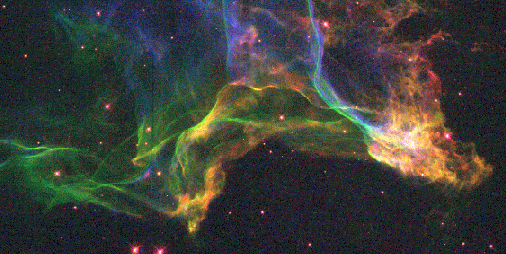
The youngest SNR in the Milky Way is G1.9+0.3. Astronomers believe it to be about 140 years old and is in the constellation Sagittarius. It is roughly 26,000 light years away.


Another interesting supernova remnant within our galaxy is the Cygnus loop(aka Veil Nebula), which is located in the constellation Cygnus. It is basically a blast wave from a stellar explosion that occurred 15,000 years ago. It spans about six times the diameter of the full moon and is 2,600 light years away.

The youngest SNR in the Milky Way is G1.9+0.3. Astronomers believe it to be about 140 years old and is in the constellation Sagittarius. It is roughly 26,000 light years away.

Friday, March 9, 2012
APOD 3.7
Conjunction Over Reunion Island
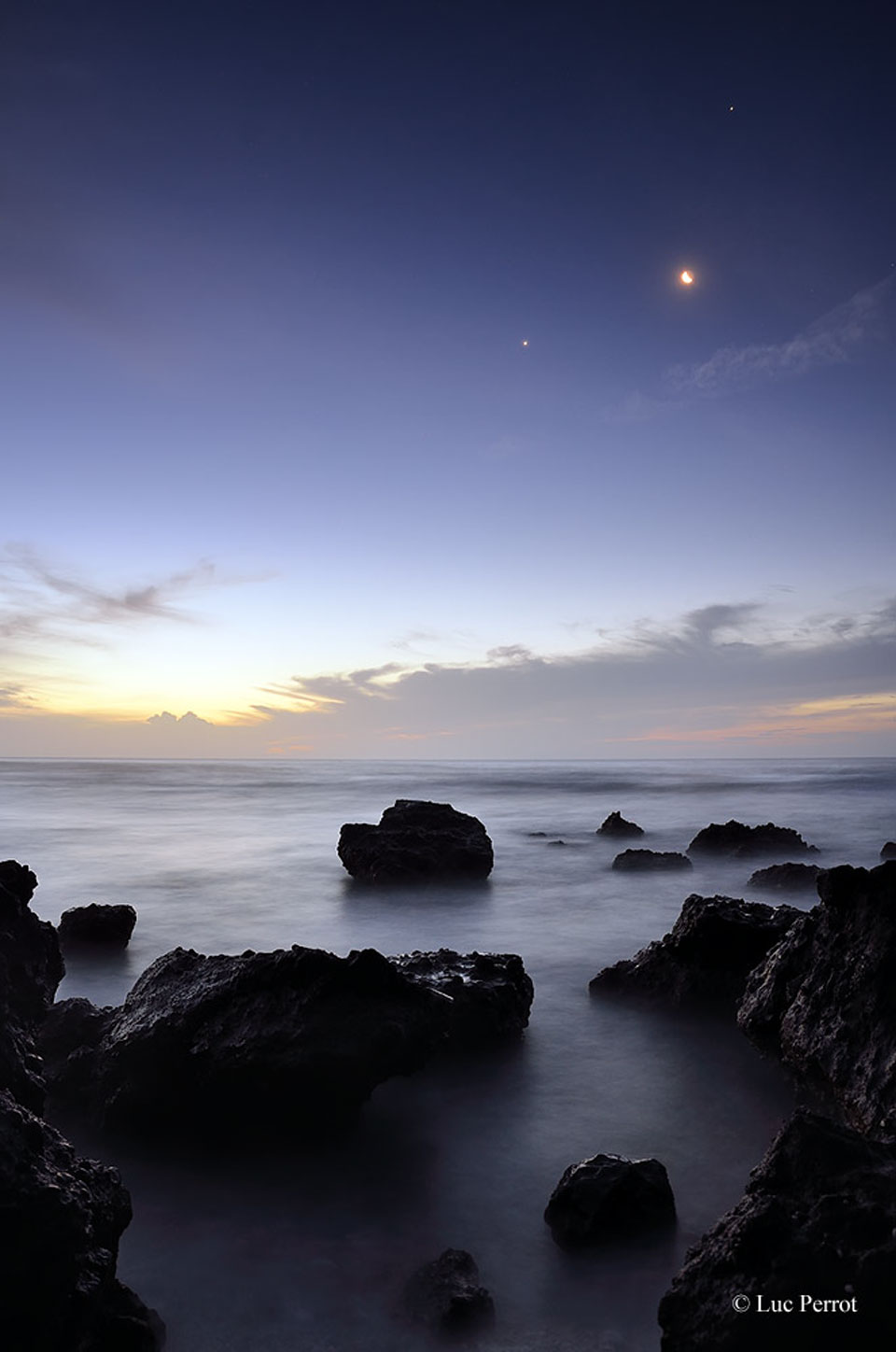
This photo was captured on Reunion Island, a French Island that is located in the Indian Ocean. The photo was taken last week and shows the conjunction of Venus, Jupiter and Mercury. The planets were joined by a bright crescent moon. The conjunction is visible anywhere if you look to the west after sunset. Venus is the brightest, and above Venus is Jupiter which is the second brightest. Mercury sits right over the horizon and is the most difficult to see. In order to get a better idea of how to spot Mercury, I found the below picture on http://earthsky.org/astronomy-essentials/pictorial-guide-to-venus-jupiter-conjunction-in-february-march-2012 .
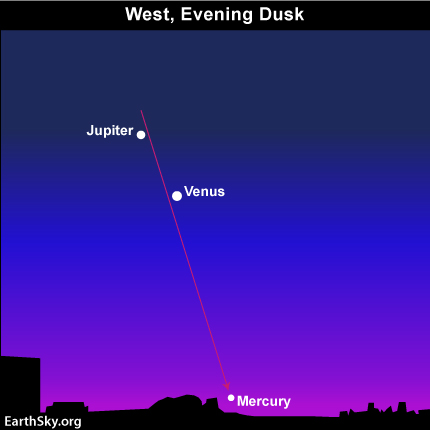

This photo was captured on Reunion Island, a French Island that is located in the Indian Ocean. The photo was taken last week and shows the conjunction of Venus, Jupiter and Mercury. The planets were joined by a bright crescent moon. The conjunction is visible anywhere if you look to the west after sunset. Venus is the brightest, and above Venus is Jupiter which is the second brightest. Mercury sits right over the horizon and is the most difficult to see. In order to get a better idea of how to spot Mercury, I found the below picture on http://earthsky.org/astronomy-essentials/pictorial-guide-to-venus-jupiter-conjunction-in-february-march-2012 .

APOD 3.6
Shocked by Supernova 1987A
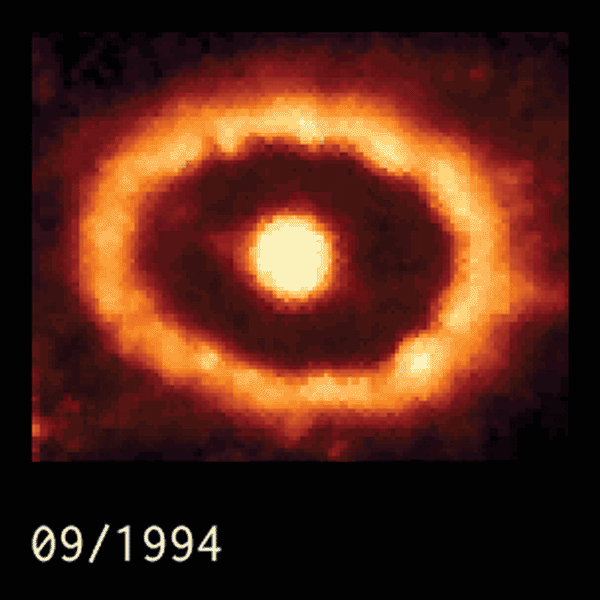
The above photo is of the brightest supernova ever sighted (twenty five years ago). The stream of images above shows the result of a collision that was recorded from 1994 to 2009 by the Hubble Space Telescope. The collision was moving at about 60 million kilometers per hour. The evolving rings of SN1987A are glowing due to shock from the collision.

The above photo is of the brightest supernova ever sighted (twenty five years ago). The stream of images above shows the result of a collision that was recorded from 1994 to 2009 by the Hubble Space Telescope. The collision was moving at about 60 million kilometers per hour. The evolving rings of SN1987A are glowing due to shock from the collision.
Tuesday, February 28, 2012
Maria Mitchell Biography

Born on August 1, 1818 in Nantucket , Massachusetts Maria Mitchell was the third out of ten children in a Quaker family. She was mostly self educated except for the short period of time when she attended a school specifically for girls. At age seventeen she opened her own school (basically just a room that she had rented). Shortly after she became a librarian at Nantucket ’s Atheneum Library.
Maria Mitchell most likely developed a passion for astronomy when her father used an observatory to conduct observations for the U.S. Coast Guard. In 1847, she discovered her first comet. Aware of her discovery, Maria’s father informed a Harvard professor of this who then contacted the king of Denmark Denmark American Academy Vassar College , a liberal arts college in New York
Thursday, February 23, 2012
How do stars form?
According to NASA, stars form in clouds of dust dispersed throughout various galaxies. A specific example of this is the Orion Nebula. In the clouds, the gas and dust collapse under their own gravitational force and the material located at their center begins to heat up. Most of this material is formed into a star while remains are dust, gas, asteroids, or other objects. According to the Discovery Channel’s program “Curiosity” stars form in the same way. The gas and dust collapse to form a protostar which collects more and more mass and gets hotter and hotter until finally, fusion occurs and a star is formed. Mainly all of the reliable sources follow the same theory: That clouds of gas and dust collapse to form protostars, which then gain mass and temperature until an actual main sequence star is formed.
Orion Nebula:
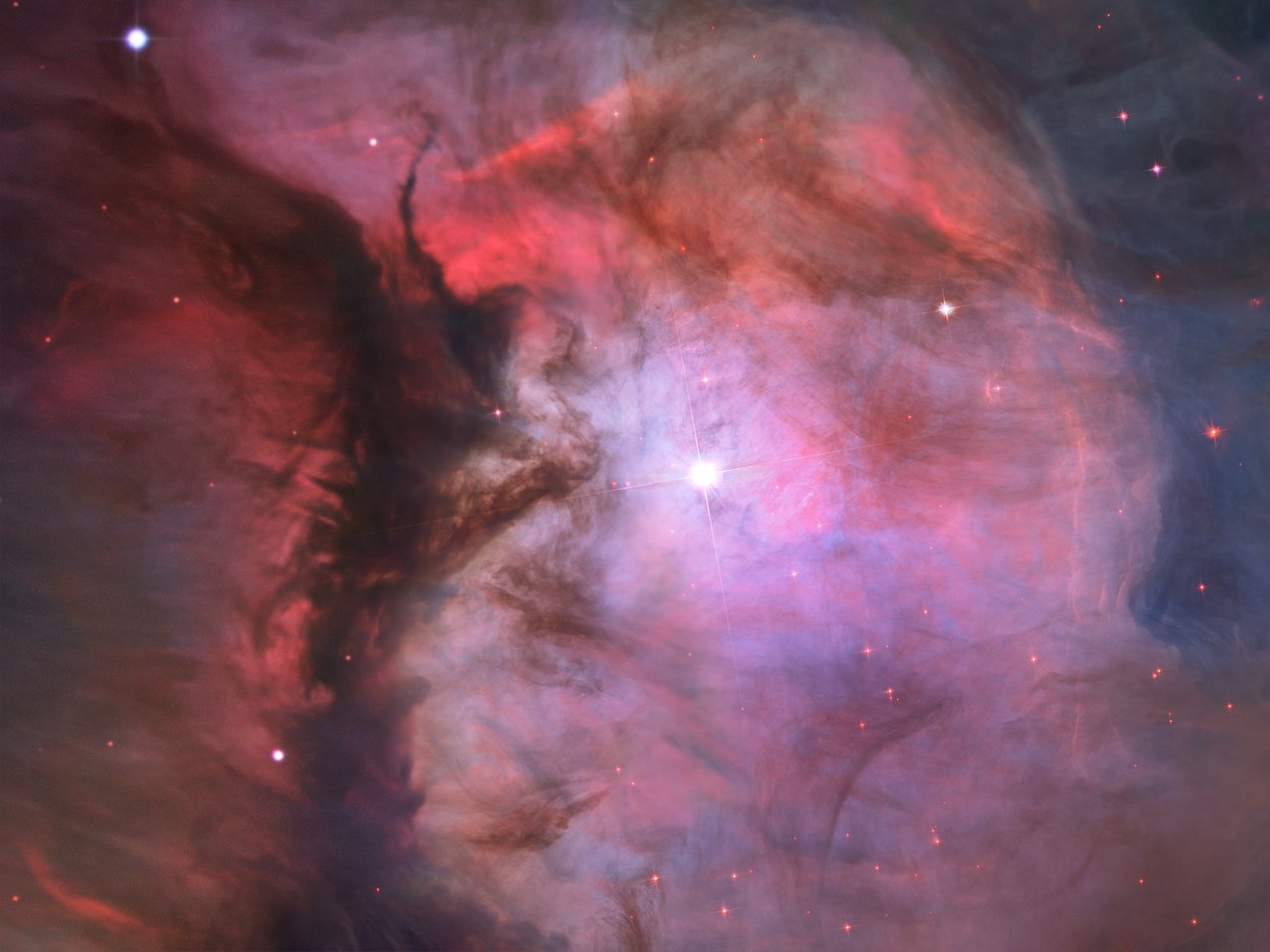
Rosette Nebula:

Friday, February 17, 2012
APOD 3.5
February 16, 2012
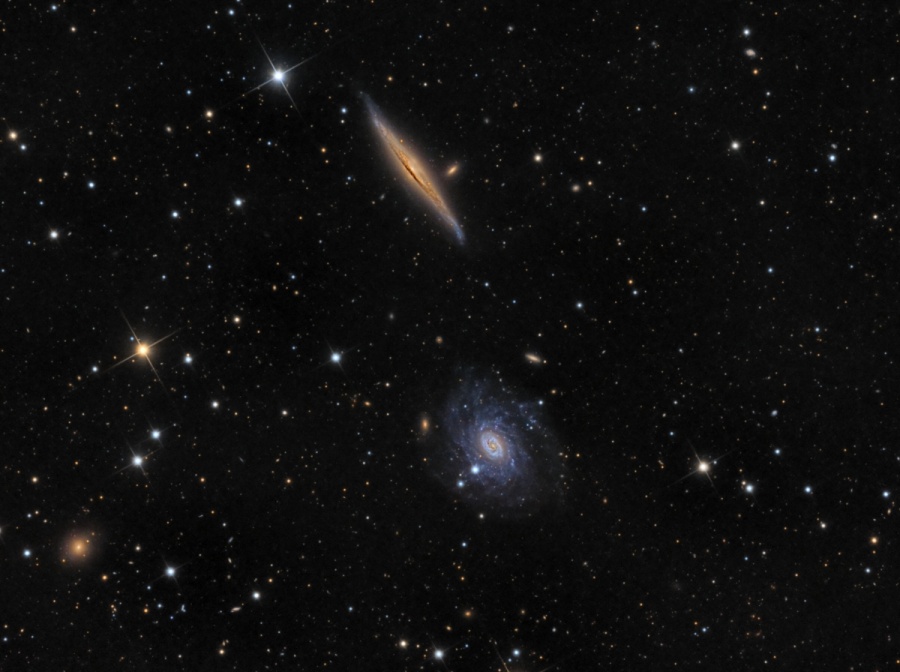
NGC 5965 and NGC 5963 in Draco
The two galaxies, NGC 5965 and NGC 5963 are located in the constellation Draco the dragon which is circumpolar. NGC 5963 is the blue galaxy viewed face on and NGC 5965 is the other spiral galaxy in the photograph. The photo also contains other galaxies as well as scattered stars from our own galaxy, The Milky Way. The two main galaxies the picture focuses on are very far away from eachother in reality although this picture is deceiving. They also have no relation to eachother. NGC 5965 spans 200,000 light years across. NGC 5963 is a low surface brightness galaxy meaning that it's luminosities are only slightly brighter than the background sky.

NGC 5965 and NGC 5963 in Draco
The two galaxies, NGC 5965 and NGC 5963 are located in the constellation Draco the dragon which is circumpolar. NGC 5963 is the blue galaxy viewed face on and NGC 5965 is the other spiral galaxy in the photograph. The photo also contains other galaxies as well as scattered stars from our own galaxy, The Milky Way. The two main galaxies the picture focuses on are very far away from eachother in reality although this picture is deceiving. They also have no relation to eachother. NGC 5965 spans 200,000 light years across. NGC 5963 is a low surface brightness galaxy meaning that it's luminosities are only slightly brighter than the background sky.
Thursday, February 16, 2012
Monday, February 13, 2012
Observations
At the stargaze on 2/12 we saw many constellations among other astronomical objects. I saw several satellites orbiting and we also were able to see Venus and Jupiter with the naked eye. We were able to see Jupiter through the telescope along with a good picture of the Pleides. A few constellations we saw were Taurus, Orion, Auriga, Gemini, Cassiopeia, Andromeda, Pegasus and part of the Big Dipper rising in the north (?). In addition we saw Ursa Minor, Aries, Perseus, Monoceros, Eridanus, Fornax, and Canis Major. It was a successful stargaze because I was able to identify a lot more than I was able to previously so I know I have improved.
Friday, February 10, 2012
APOD 3.4
February 9, 2012:
http://apod.nasa.gov/apod/ap120209.html
The video above (link) shows various settings in which auroras occur.The video is specifically a timelapse display filmed in Norway. Recently, our Sun has become more active, therefore giving off more solar flares and CME's which can result in auroras. Astronomers predict that we will be seeing even more auroras in the future since solar maximum has still not occured.
http://apod.nasa.gov/apod/ap120209.html
The video above (link) shows various settings in which auroras occur.The video is specifically a timelapse display filmed in Norway. Recently, our Sun has become more active, therefore giving off more solar flares and CME's which can result in auroras. Astronomers predict that we will be seeing even more auroras in the future since solar maximum has still not occured.
Friday, February 3, 2012
APOD 3.3
January 30, 2012: Blue Marble Earth from Suomi NPP
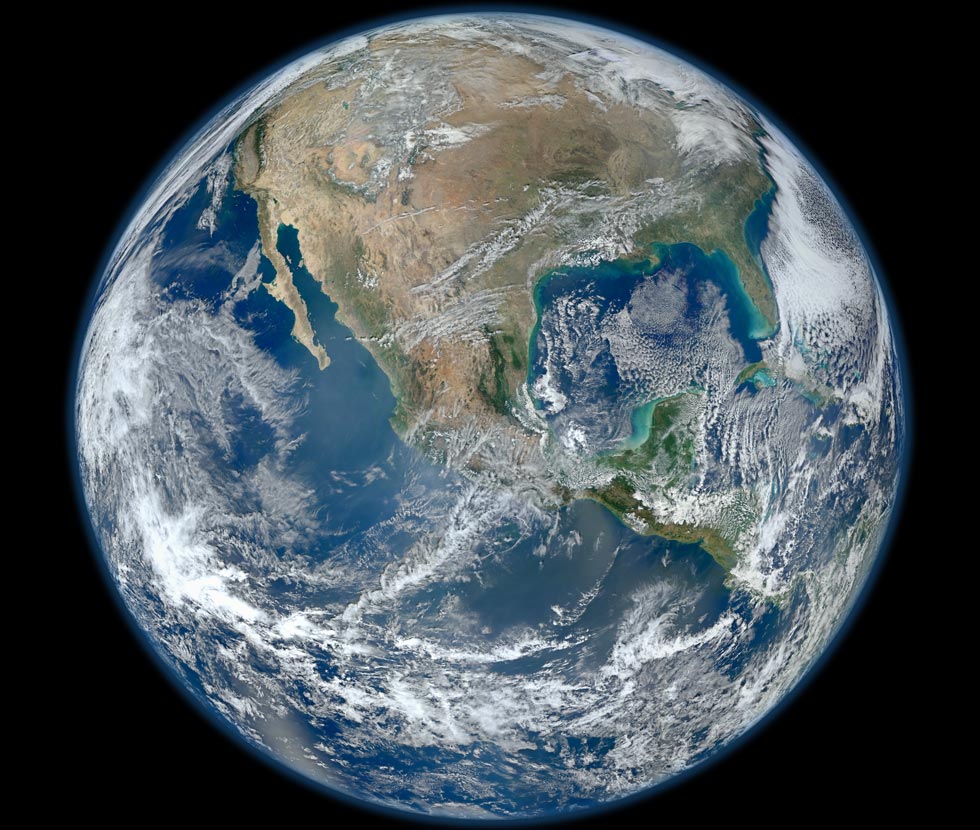
This photo of Earth is actually comprised of several photos taken by Suomi NPP (an Earth observing satellite launched by NASA) and a VIIRS instrument ( Visible/Infrared Imager Radiometer Suite- the primary imaging tool onboard Suomi NPP). In order to put together such a photograph, the satellite had to make four orbits. The data collection was done earlier in January.

This photo of Earth is actually comprised of several photos taken by Suomi NPP (an Earth observing satellite launched by NASA) and a VIIRS instrument ( Visible/Infrared Imager Radiometer Suite- the primary imaging tool onboard Suomi NPP). In order to put together such a photograph, the satellite had to make four orbits. The data collection was done earlier in January.
Friday, January 27, 2012
APOD 3.2
January 21, 2012

Days in the Sun:
This photograph is a compression of time (June 21st to December 21st in 2011) and is called a solargraph, a picture that captures the path of the Sun. The picture was taken using a pinhole camera made from a drink can lined with photographic paper. Pinhole cameras are typically used with time, the Sun, and astronomy in general. The gaps in the arcs are indicative of cloud cover, where as the continually bright streaks represent sunny weather. The trails are higher in June due to the summer solstice and sink in December due to the winter solstice.

Days in the Sun:
This photograph is a compression of time (June 21st to December 21st in 2011) and is called a solargraph, a picture that captures the path of the Sun. The picture was taken using a pinhole camera made from a drink can lined with photographic paper. Pinhole cameras are typically used with time, the Sun, and astronomy in general. The gaps in the arcs are indicative of cloud cover, where as the continually bright streaks represent sunny weather. The trails are higher in June due to the summer solstice and sink in December due to the winter solstice.
Tuesday, January 24, 2012
APOD 3.1
January 17, 2012: The Witch Head Nebula
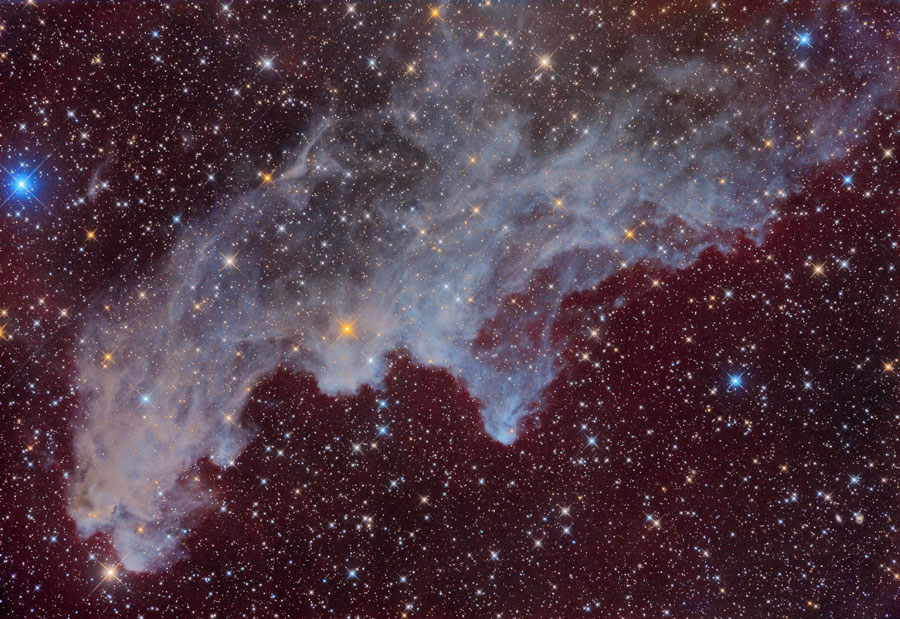
The Witch Head Nebula is a reflection nebula (meaning it reflects light from a star close to it). It is linked to Rigel located in the constellation Orion. Rigel provides the light primarily reflected by this nebula. The blue color is partly caused by Rigel's color but also the blue color is due to the fact that the particles of dust reflect blue light more efficiently than red light. For the same reason, Earth's sky appears blue. The Witch Head nebula is roughly 1000 light-years away.

The Witch Head Nebula is a reflection nebula (meaning it reflects light from a star close to it). It is linked to Rigel located in the constellation Orion. Rigel provides the light primarily reflected by this nebula. The blue color is partly caused by Rigel's color but also the blue color is due to the fact that the particles of dust reflect blue light more efficiently than red light. For the same reason, Earth's sky appears blue. The Witch Head nebula is roughly 1000 light-years away.
Friday, January 13, 2012
Astronomy Cast 2
The Tunguska Event
One morning in Siberia (June 30th, 1908) something unknown caused massive destruction when it streaked across the early sky. Investigations were not set up until 1921. They found that the total area of damage spanned about 800 square miles. When further investigation was done, nothing was found in the center of debris besides a tree stump. Finally, in 1978 (70 years later!) astronomer Lubor Kresak realized that the Tunguska event occurred at the height of a Beta Taurid meteor shower. He believed that the destruction was caused by Comet Encke. Today, scientists believe it to be a asteroid comet hybrid (possibly). What I found most amazing about this entire thing was that it took decades to actually even begin to thoroughly investigate what happened.
One morning in Siberia (June 30th, 1908) something unknown caused massive destruction when it streaked across the early sky. Investigations were not set up until 1921. They found that the total area of damage spanned about 800 square miles. When further investigation was done, nothing was found in the center of debris besides a tree stump. Finally, in 1978 (70 years later!) astronomer Lubor Kresak realized that the Tunguska event occurred at the height of a Beta Taurid meteor shower. He believed that the destruction was caused by Comet Encke. Today, scientists believe it to be a asteroid comet hybrid (possibly). What I found most amazing about this entire thing was that it took decades to actually even begin to thoroughly investigate what happened.
Astronomy Cast 1
Galileo Galilei
While reading over this astronomy cast, I was surprised that I actually learned a lot. In his early years, Galileo was pushed to be a priest by his father but he instead chose to attend the University of Pisa to go to medical school. There he decided to go into mathematics and he also studied art. In the midst of things, he insulted the church and there was some conflict in his life due to that. He taught geometry, mechanics, and astronomy until 1610. He also had three children, all with the same woman, two of which were girls. Another thing I learned about Galileo was that he was the first to observe Saturn's rings or "ears" since he thought they looked like handles. I also learned that he was rather cocky, I suppose I would be too with his list of accomplishments. What I found most interesting about this podcast were the facts about Galileo's personal life and personality because that's not really something we learn about in the classroom.
While reading over this astronomy cast, I was surprised that I actually learned a lot. In his early years, Galileo was pushed to be a priest by his father but he instead chose to attend the University of Pisa to go to medical school. There he decided to go into mathematics and he also studied art. In the midst of things, he insulted the church and there was some conflict in his life due to that. He taught geometry, mechanics, and astronomy until 1610. He also had three children, all with the same woman, two of which were girls. Another thing I learned about Galileo was that he was the first to observe Saturn's rings or "ears" since he thought they looked like handles. I also learned that he was rather cocky, I suppose I would be too with his list of accomplishments. What I found most interesting about this podcast were the facts about Galileo's personal life and personality because that's not really something we learn about in the classroom.
APOD 2.8
Jan. 11, 2012: Little Planet Lovejoy

This photo of comet Lovejoy, taken on December 30th in the morning shows the comet on the edge of Earth. The photo was put together using little planet projection, which is a type of stereographic projection used to map the image pixels. The stars Sirius and Canopus are also visible in this photo (taken in Victoria, Australia) and are to the right of the planet. Comet Lovejoy's tail is visible to the northwest of Earth.

This photo of comet Lovejoy, taken on December 30th in the morning shows the comet on the edge of Earth. The photo was put together using little planet projection, which is a type of stereographic projection used to map the image pixels. The stars Sirius and Canopus are also visible in this photo (taken in Victoria, Australia) and are to the right of the planet. Comet Lovejoy's tail is visible to the northwest of Earth.
Wednesday, January 11, 2012
Charles Messier Biography
Charles Messier was born in Badonviller, Lorraine, France on June 26, 1730 and died in Paris, France on April 11 (or 12), 1817. The exact date of Messier’s death is still unknown to this day. He was the tenth out of a family of twelve children. His father died when he was only eleven years of age, but that did not prevent him from achieving great things. In 1751, he moved to Paris Paris
In 1759, on January 21st, he spotted Halle Halle Berlin and St. Petersburg Sweden , a member of the Netherlands Society of Sciences, and a member of the Institute of Bologna
Sunday, January 8, 2012
APOD 2.7
January 5, 2012: Ringside with Titan and Dione
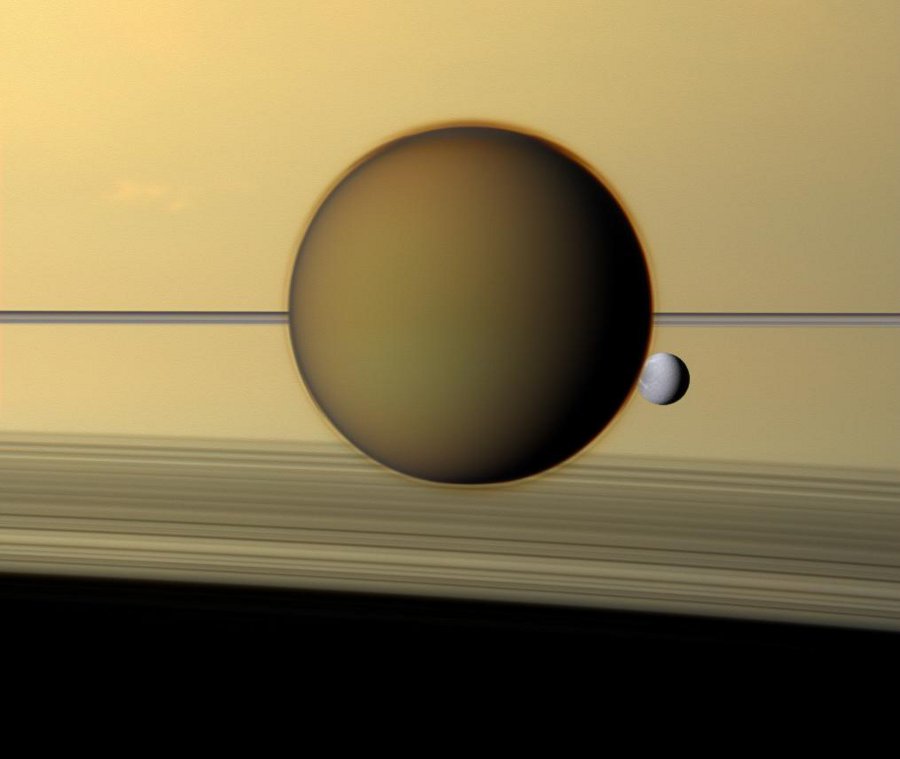
Titan and Dione are two of fifty-three Saturnian moons that orbit the planet in the plane of it's rings. The above picture, captured by the Cassini spacecraft, features the two moons and Saturn's rings visibly in the background. Titan is the largest moon of Saturn (with a radius of 2,575 kilometers) and is the second largest moon in our solar system, only smaller than Jupiter's Ganymede. Dione is the third largest moon of Saturn and has a diameter of 1,123 kilometers. Titan is 2.3 million kilometers from the Cassini spacecraft and Dione is 3.2 million kilometers. The moons are much farther from the spacecraft than they are from the gas giant.

Titan and Dione are two of fifty-three Saturnian moons that orbit the planet in the plane of it's rings. The above picture, captured by the Cassini spacecraft, features the two moons and Saturn's rings visibly in the background. Titan is the largest moon of Saturn (with a radius of 2,575 kilometers) and is the second largest moon in our solar system, only smaller than Jupiter's Ganymede. Dione is the third largest moon of Saturn and has a diameter of 1,123 kilometers. Titan is 2.3 million kilometers from the Cassini spacecraft and Dione is 3.2 million kilometers. The moons are much farther from the spacecraft than they are from the gas giant.
Friday, January 6, 2012
Charles Messier Biography Sources
The Gale Encyclopedia of Science:
http://www.astro-tom.com/messier/messier_files/messier_biography.htm
Subscribe to:
Posts (Atom)



